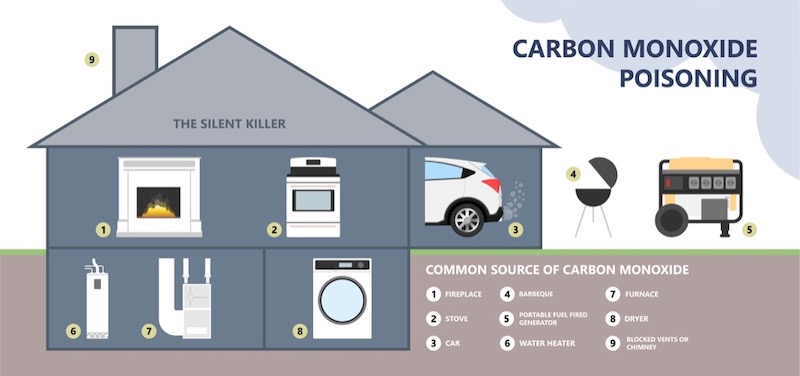Physical Address
304 North Cardinal St.
Dorchester Center, MA 02124
Physical Address
304 North Cardinal St.
Dorchester Center, MA 02124

Contents
Carbon monoxide (CO) is a dangerous gas that can be found in homes and poses serious health risks to individuals. Understanding the sources and causes of carbon monoxide buildup is crucial in preventing potential harm to you and your family. Let’s delve into the various factors that can lead to carbon monoxide accumulation in a house.
One of the primary reasons for carbon monoxide buildup in a house is improperly installed or poorly maintained appliances. Appliances such as stoves, hot water heaters, furnaces, fireplaces, and gas ranges that are not installed correctly or lack proper ventilation can be sources of carbon monoxide emissions. Over time, these appliances may develop issues that lead to the release of this harmful gas into the indoor environment.
Regular maintenance and inspection of fuel-burning appliances are essential to ensure they are functioning correctly and not producing excessive amounts of carbon monoxide. Hiring a qualified professional to inspect these appliances annually can help identify any potential problems and prevent carbon monoxide buildup.
Poorly ventilated spaces can also contribute to the accumulation of carbon monoxide in a house. When there is insufficient airflow to remove the gas produced by fuel-burning appliances, CO can build up to dangerous levels. This is especially common in homes with sealed windows and doors, as well as in properties with blocked vents or chimneys.
Ensuring proper ventilation in areas where fuel-burning appliances are located is crucial for preventing carbon monoxide buildup. Regularly checking vents, chimneys, and exhaust systems to make sure they are clear of any obstructions can help maintain a safe indoor environment.
Using heating methods that are not intended for indoor spaces can also lead to carbon monoxide issues in a house. For example, using a gas oven or stove as a heating source can release CO into the air, posing a significant health risk. Similarly, running a generator indoors or in an enclosed space can result in dangerous levels of carbon monoxide.
It is essential to follow manufacturer guidelines and safety recommendations when using heating appliances and devices in your home. Avoid using outdoor equipment indoors and always ensure proper ventilation when operating fuel-burning devices.
Now that we have explored the common causes of carbon monoxide in a house, it is crucial to take proactive measures to safeguard your family from potential exposure to this harmful gas. Here are some essential steps you can take to protect your loved ones:
Installing carbon monoxide alarms in key areas of your home is a critical safety measure. Place CO detectors outside every sleeping area and on every level of your house to ensure comprehensive coverage. Test the alarms monthly to ensure they are functioning correctly and replace the batteries at least once a year.
Carbon monoxide alarms can alert you to the presence of CO in your home and provide early warning in case of a buildup. In the event of an alarm, evacuate the premises immediately and seek assistance from emergency services.
Regular maintenance of fuel-burning appliances is essential to prevent carbon monoxide emissions. Schedule annual inspections by qualified technicians to check for any issues and ensure proper ventilation. Look out for signs of soot, rusting, or unusual odors that may indicate a problem with the appliance.
By keeping your appliances in good working condition, you can reduce the risk of carbon monoxide buildup and protect your family from potential harm.
When it comes to heating your home, always follow safety guidelines to avoid carbon monoxide exposure. Never use ovens or stoves as heating sources, and refrain from running generators or other gas-powered equipment indoors. Proper ventilation and outdoor use of such devices are essential to prevent CO buildup.
By adopting safe heating practices and being mindful of the potential sources of carbon monoxide in your home, you can create a safer environment for your family.
Carbon monoxide buildup in a house can have serious consequences, but by understanding the causes and taking preventive measures, you can protect your family from this invisible threat. By installing CO alarms, maintaining appliances, ensuring proper ventilation, and practicing safe heating habits, you can minimize the risk of carbon monoxide exposure and create a safer living environment for you and your loved ones.